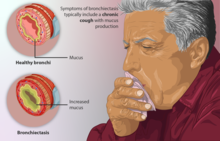| Obstructive lung disease | |
|---|---|
 | |
| Depiction of a person with bronchiectasis, a type of obstructive lung disease | |
| Specialty | Pulmonology |
Obstructive lung disease is a category of respiratory disease characterized by airway obstruction. Many obstructive diseases of the lung result from narrowing (obstruction) of the smaller bronchi and larger bronchioles, often because of excessive contraction of the smooth muscle itself. It is generally characterized by inflamed and easily collapsible airways, obstruction to airflow, problems exhaling, and frequent medical clinic visits and hospitalizations. Types of obstructive lung disease include asthma, bronchiectasis, bronchitis and chronic obstructive pulmonary disease (COPD). Although COPD shares similar characteristics with all other obstructive lung diseases, such as the signs of coughing and wheezing, they are distinct conditions in terms of disease onset, frequency of symptoms, and reversibility of airway obstruction.[1] Cystic fibrosis is also sometimes included in obstructive pulmonary disease.[2]
- ^ National Asthma Education and Prevention Program. Clinical Practice Guidelines. Expert Panel Report 2. Guidelines for the Diagnosis and Management of Asthma. Bethesda, Md: National Heart, Lung, and Blood Institute, National Institutes of Health, US Dept of Health and Human Services; 1997. NIH publication 97-4051.
- ^ Restrepo RD (September 2007). "Inhaled adrenergics and anticholinergics in obstructive lung disease: do they enhance mucociliary clearance?" (PDF). Respir Care. 52 (9): 1159–73, discussion 1173–5. PMID 17716384. Archived from the original (PDF) on 2017-04-10. Retrieved 2008-07-21.